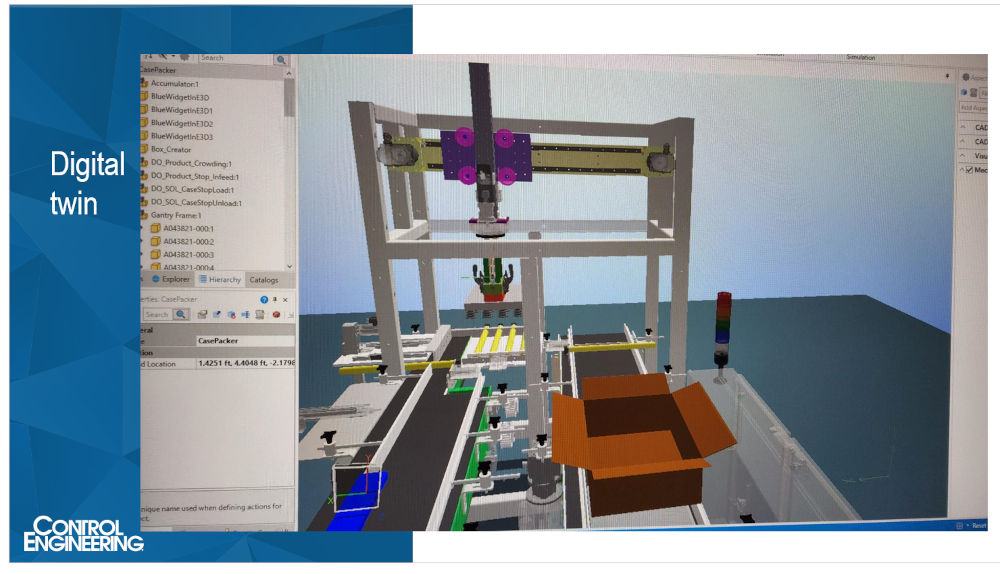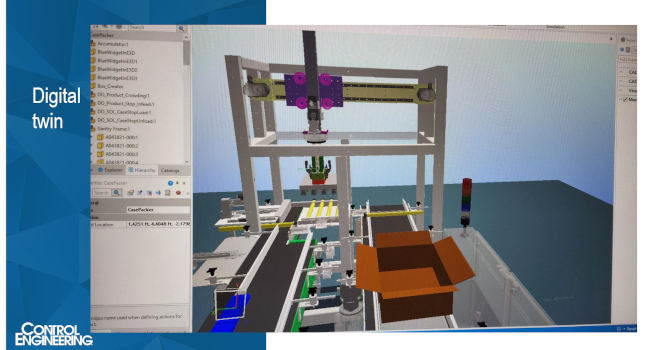Digital twins advance digital transformation, control system integration
Control system integrators explain how simulation and digital twin software can advance competitiveness by enabling ideas, design, testing, training, installation, upgrades and optimization of automated systems. ChatGPT artificial intelligence software adds seven tips for using simulation software for automation and controls.
Learning Objectives
- Explore simulation and digital twins use for automation and controls as explained by control system integrators.
- Understand that digital twins are underused in automation project design and that simulation software advantages expand in digital twin implementations.
- Review seven ways simulation software advances digital transformation by ChatGPT.
Using simulation software and digital twins can help with effective integration of automation and controls to advance competitiveness, said Craig Salvalaggio, chief operating officer, Applied Manufacturing Technologies (AMT), and Keith Mandachit, PE, engineering manager, Huffman Engineering. The control system integrators spoke in the Control Engineering March 8 webcast, “How to automate series: Control system integration advances competitiveness.” Also see ChatGPT’s seven tips.
Simulation, digital twins for automation and controls
Mandachit said system integrators need to understand customer needs. Being able to visually represent what those project needs in a simulation is even better. Simulation is an underused strategy, and he expects to see more of it “as we move into this digitalization age.”
Simulation software enables testing to happen before installation. It enables innovation through testing of ideas and strategies without the capital expenditure to build a system. It allows for operator training prior to having ready-to-operate system. All of those evaluative components mean that design is smarter, faster and more exact when the actual design comes together.
Salvalaggio touted simulation among his “lessons learned” recommendations, explaining that simulation software can be used to replicate discrete events, model plant processes and workflows and do virtual commissioning for automation projects.
Digital twins are underused in automation project design
Digital twin software can help create and thoroughly test a machine or process without physically building and installing it, Mandachit said. For example, suppose a project is under consideration to run a conveyer through a machine. Creating a simulation can show if a machine design can keep up with the conveyer running at a certain rate of speed or easily show how a smaller machine might still meet objectives and fit in less floor space. The digital twin even can help with operator training prior to having the system ready for production.
Prior to more details being available for a digital twin, Mandachit said, we’ve always been able to do simulations in software with programming, hooking up some switches, force things on and off, manipulate data and register values and see how the logic would function.
Expanding that to a digital twin shows how more processes interact and helps in planning, designing, testing and upgrading the control system design. Now, he said, we can test code and whole processes ahead of time, not just bits and pieces.
Salvalaggio suggested, for example, a digital twin could show how elements could be introduced into a work cell and determine effect on designed the application’s workflow, motion and perimeter guarding, to better plan, look at scenarios and potentially do virtual commissioning.

As part of the 2023 “How to automate series” of webcasts, system integrators explain, in part, how simulation and digital twins help advance competitiveness. Keith Mandachit, PE, engineering manager, Huffman Engineering, explained how software can create a digital twin of a machine or process to plan and test prior to building and installation. Courtesy: Control Engineering webcast, Huffman Engineering
Simulation software advantages expand in digital twins
Salvalaggio described simulation in three degrees of difficulty.
- Simulation can add a lot of value as a planning tool for visualization to help conceptualize system designs in a factory, helping with more than just a two-dimensional layout could do.
- Going a step further, software can simulate feeds, payloads, kinematics, robotics, conveyers, product flow and process throughput, well beyond just one work cell’s design. Advanced simulations help with more engineering-level work, provide feedback for offline programming and reduce system integration and onsite installation time.
- Most useful and challenging is a full digital twin that’s kept up to date as things change from as-built work-cell drawings to what actually happens in a facility. New information needs to update the digital model as part of workflow processes to realize “a ton of value.”
Salvalaggio observed that simulation and digital twin software capabilities are advancing, and costs are falling. “In five years, I think we’ll see digital twins more widely adopted,” especially as larger companies develop a critical mass of implementations and add value.
Mandachit said digital twins can help with optimization, to see if proposed changes will bring expected returns prior to risking time and resources to make physical changes to a system. Simulation and digital twin use helps facilities better plan to accommodate production demands and changes.
7 ways simulation software advances digital transformation
Control Engineering asked ChatGPT artificial intelligence (AI) software how automation and control applications can use simulation software. The edited response follows.
Simulation software can be a powerful tool for automation and control applications as it allows for testing of programming upgrades, redesigns, optimization and training in a safe and controlled environment before implementing them on the plant floor.
Seven tips can help effectively use simulation software for automation and controls:
- Identify the scope of the simulation: Clearly define the process that needs to be simulated, including all inputs, outputs, and other relevant factors that affect the system.
- Choose the appropriate simulation software: Choose simulation software that is capable of accurately representing the system being modeled and has the necessary features for the analysis required.
- Gather accurate data: Collect accurate data about the process being modeled, such as input/output data, operating parameters, and other relevant information. This information will help ensure that the simulation accurately represents the real-world system.
- Validate the simulation: Once the simulation is complete, validate it by comparing its results with the actual results from the real-world system. This will help to ensure that the simulation is accurate and reliable.
- Use the simulation for training: Simulation software can be used to train operators and engineers on new processes or upgrades. It provides a safe and controlled environment for testing and learning, without the risk of causing damage to the actual system.
- Use the simulation for optimization: Simulation software can also be used for optimizing the process. By testing various scenarios and settings, engineers can identify the most efficient and effective way to run the system.
- Iterate and refine: Use the simulation software to test and refine various designs, upgrades or optimization strategies before implementing them on the plant floor. This can help to save time, resources and prevent costly errors.
Simulation software can be a valuable tool for automation and control applications, allowing for the testing of upgrades, redesigns, optimization and training in a safe and controlled environment. By following best practices and using the appropriate software, engineers can improve the accuracy, reliability and efficiency of control systems.
Mark T. Hoske is content manager, Control Engineering, CFE Media and Technology, mhoske@cfemedia.com, and webcast moderator. The “7 ways simulation software advances digital transformation” content was created using ChatGPT, and due to limits of AI tools, also edited and reviewed by Hoske.
KEYWORDS: Simulation, digital twins, system integration, automation upgrades
CONSIDER THIS
Are you using simulation and digital twins to expedite and improve migrations and upgrades?
ONLINE
Second in the “How to Automate” series is available for viewing until March 8, 2024.
The first webcast in the 2023 “How to Automate” series is available for viewing until Jan. 18, 2024.
For more on digital twins from Control Engineering, see:
https://www.controleng.com/digital-transformation/digital-twins/
For more on simulation from Control Engineering, see:
https://www.controleng.com/process-instrumentation-sensors/simulators-optimizers/
Do you have experience and expertise with the topics mentioned in this content? You should consider contributing to our CFE Media editorial team and getting the recognition you and your company deserve. Click here to start this process.


